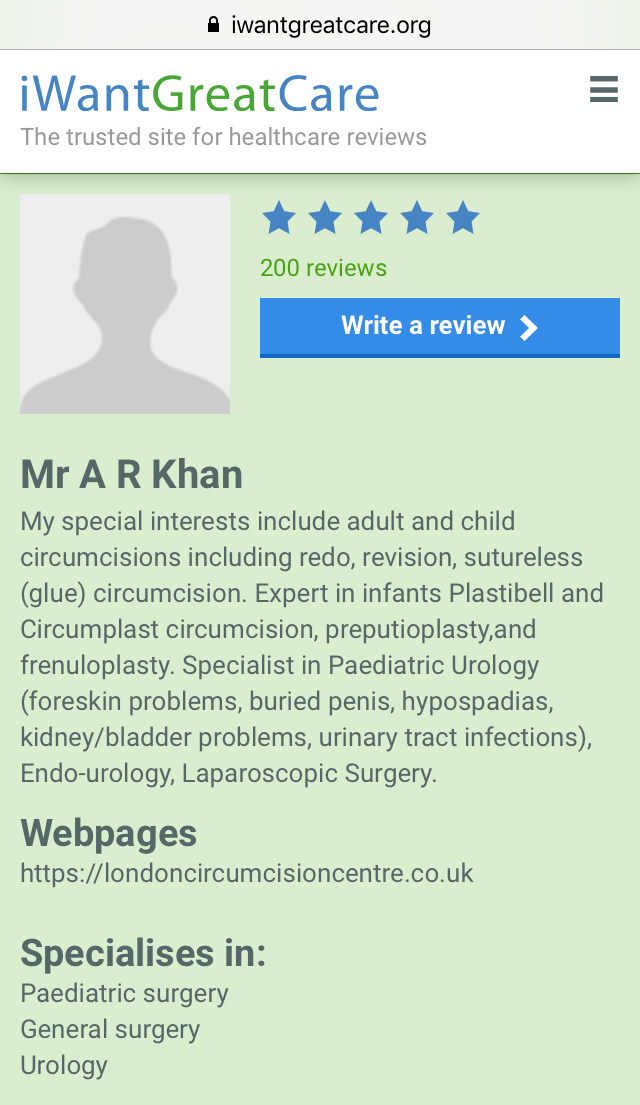Before the circumcision in infants and children, every child anatomy is different, and their shape or size of penis and foreskin are also different. Penis is sometimes rotated, bended or buried in pubic areas. When parents arrange a circumcision, they may have in mind that the child will look like the father or head of the penis may not be completely exposed as religious or cultural requirements, but this is definitely not the case in some children. Children develops differently as well. Degree of buried penis can change as child grows older.
Hypospadias describes an anatomical variant where the wee hole (external mental opening) did not complete its development and did not close fully to the tip of the penis leaving an opening along the underside of the penis. Opening could be present away from tip of the penis to scrotum or perineum. This also requires hypospadias repair under general anaesthesia and the foreskin may be helpful for this purpose, so circumcision must not be done until the hypospadias repair is done. In most of the cases, you can recognise as foreskin is hooded. In some cases, hypospadias may be present on intact foreskin and described as megameastus or glandular hypospadias. This can only recognised after retracting the foreskin and circumcision should be postponed until hypospadias repair is done.
Some babies, infants and children have long and skinny penis and others short and fat penis. Some have showed bending to the left or to the right before or after circumcision. Some children penis is buried into the abdominal fat. Some are more bent than others, even more to 90 degrees. This markedly bent penis is described as a penile chordee and requires paediatric urology to straighten, and the foreskin is useful for this procedure in these cases, so should not have circumcision until the corrective operation of penile chordee is done under general anaesthesia in the hospital.
Buried penis is very common now a days. In most of the cases, it is mild form which may not require any further corrective surgery and it is possible to do circumcision. Many boys have loose attachment of the skin to the shaft of the penis. In these children, there may be a high insertion of the scrotal skin along the underside of the shaft of the penis, or there may be a pad of “puppy fat” in front of the pubic bone pushing the skin forward and away from the penis which is anchored at its internal base to the pubic bone. The penis appears to disappear behind the skin, and this is sometimes referred to as the “Disappearing Penis Syndrome”. It is also referred to as a “buried penis”, "hidden penis" or "inconspicuous penis"
It is primarily an issue of loose attachment of the skin and it is usual for the penis to “reappear” by the time the child is about 1-6 years of age, with the reduction in this pubic fat and the growth of the child. However, some few older children or adults retain this appearance at rest; yet, it looks and performs perfectly adequately in sexual situations.
This anatomical variant, however, causes the parents concern after a circumcision, because as the skin moves forward over the head of the penis, it appears that not enough skin has been removed. This is not the case. The paediatric urologist ( Mr A R Khan) has to estimate the length of skin to leave in order that when the child is grown, there will be enough skin to cover the erect penis and not leave too much area that will be covered by scar tissue. It is only in the infant years, then, that the child may appear to have been inadequately circumcised.
It is very important in such boys, that the parents retract the cut foreskin regularly to prevent the cut edge healing and attaching to the head of the penis after 3 days of separation of the ring circumcision and creating a cosmetic result that is not desired. Therefore, if you notice that the skin of the penis is falling forward covering the head of the penis at any time after the operation, even up to a few years later, ( such that it looks like not enough skin was removed), then please have the child reviewed at our clinic by Dr. Khan. He will explain to you how to manage the skin so as not to form permanent attachments to the head of the penis, and he may have to separate the skin from head (glans) of penis for you at times or referral to the GP for further managamnet at tertiary centre in UK..
The content on the our website is not intended nor recommended as a substitute for medical advice, diagnosis, or treatment. Always seek the advice from Dr. Khan regarding any medical questions or conditions developed after circumcision.




